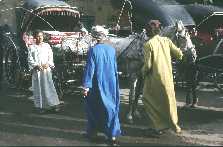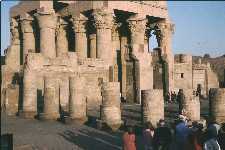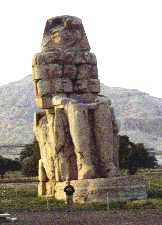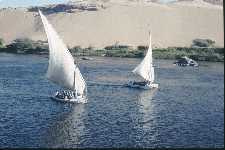Our guide had spent 4 years learning the history of ancient Egypt and gave
us the benefit of his learning. He was well versed in every detail of the
temples and expounded at length on the history of the Pharaohs and their
subjects. Our group numbered about 30 people but our guide in a brightly
coloured hat stood out from the crowd. Around us the red sandstone pillars
towered above us. They were deeply inscribed with symbols, which are still
visible 3300 years later. A few solitary palm trees seemed to grow out of the
stone but there was little else. Presently the call for prayer drowned the voice
of our guide and we moved on.
We had flown direct to Luxor from the UK to tour the ancient sites by
spending seven days navigating The Nile, pausing every day at a different site
to see the surviving monuments to the ancient Egyptian civilisation. The tour
was planned to visit alternate sites on the way up the river and then, on the
way back, fill in those we had missed.
Travelling in a portable hotel is a restful way of touring. Our luggage
moved with us without the need to pack and unpack at every stop. On the way
upriver from Luxor to Esna the scenery would drift past the picture window of
our cabin, or we could sit on the sun deck under the awning and watch the wash
from the boat.
 A ride on a caleche was an adventurous way to visit the temple at Ednu. On
seeing my camcorder the driver invited me to sit beside him. Perched higher in
the front of the vehicle, I had an interrupted view of the surroundings. The
horse trotted along the muddy road wet with ponds of water after a recent shower
before arriving at the temple. It was surrounded by a mass of caleches. An
abundance of colour came from the stalls in the market where clothing was
displayed for inspection. A man playing a one stringed instrument made strident
tones that penetrated the conversation but contributed to the atmosphere. It was
a typical working day with many traders bustling around the stalls.
A ride on a caleche was an adventurous way to visit the temple at Ednu. On
seeing my camcorder the driver invited me to sit beside him. Perched higher in
the front of the vehicle, I had an interrupted view of the surroundings. The
horse trotted along the muddy road wet with ponds of water after a recent shower
before arriving at the temple. It was surrounded by a mass of caleches. An
abundance of colour came from the stalls in the market where clothing was
displayed for inspection. A man playing a one stringed instrument made strident
tones that penetrated the conversation but contributed to the atmosphere. It was
a typical working day with many traders bustling around the stalls.
At Edfu the Temple to Horus, the Falcon god, is well preserved having been
built comparatively recently in 237-57 BC. On the impressive gateway to the
temple the carvings are still on the walls although the colours are fading.
The relief is well preserved. Nearby river barges ferry bricks and the quarry is
worked for stone.
 It is not far to Kom Ombo where the Greco-Roman temple of Haroerus and Sobek was
built during the period 181 BC to 219 AD on the ruins of an 11th dynasty site.
It is unusual in being dedicated to two deities. The god Sobek has a crocodile
head and the god Haroerus is portrayed as a falcon. In order to treat the two
gods equally the temple is symmetrical about its centre.
It is not far to Kom Ombo where the Greco-Roman temple of Haroerus and Sobek was
built during the period 181 BC to 219 AD on the ruins of an 11th dynasty site.
It is unusual in being dedicated to two deities. The god Sobek has a crocodile
head and the god Haroerus is portrayed as a falcon. In order to treat the two
gods equally the temple is symmetrical about its centre.
 The tourist cannot fail to be impressed by the feats of building and
construction, sometimes involving columns weighing over a 1000 tons. Splitting
of the stone was achieved by drilling a series of holes in line and then
hammering in dry wooden plugs. When wetted, the enormous forces generated by the
expanding wood were enough to split the stone along the line of the holes. It is
believed that the technique of swelling wood was also used to position blocks of
stone next to each other. A visit to a sculptors workshop showed us the
traditional methods of working with stone, using chisels, axes and files, and a
boring instrument that needed two men to operate.
The tourist cannot fail to be impressed by the feats of building and
construction, sometimes involving columns weighing over a 1000 tons. Splitting
of the stone was achieved by drilling a series of holes in line and then
hammering in dry wooden plugs. When wetted, the enormous forces generated by the
expanding wood were enough to split the stone along the line of the holes. It is
believed that the technique of swelling wood was also used to position blocks of
stone next to each other. A visit to a sculptors workshop showed us the
traditional methods of working with stone, using chisels, axes and files, and a
boring instrument that needed two men to operate.
If you wish to feel miniscule then a visit to the Colossi of Memnon that
are nearly 60 feet high, is a must. They are all that remain of the temple of
Amenophis III, the stone was plundered by subsequent pharaohs for their building
work elsewhere.
 With an enthusiastic guide the visitor is likely to become saturated with
Egyptian culture. Accordingly a Felucca ride on the river provides a welcome
relief. They are sturdily constructed with a lateen sail capable in a stiff
breeze of taking 20 - 30 people at a brisk pace to the botanical gardens on
Kitchener island. Here there is an abundance of pink and mauve flowers that
mingle with numerous shrubs. Egyptian families visit for a picnic amid the
impressive scenery with a backdrop of a blue sky against pinkish-red sandstone
hills. It is a busy scene, and with a flotilla of feluccas issuing warnings to
each other with loud horns, the guides comments go unheard.
With an enthusiastic guide the visitor is likely to become saturated with
Egyptian culture. Accordingly a Felucca ride on the river provides a welcome
relief. They are sturdily constructed with a lateen sail capable in a stiff
breeze of taking 20 - 30 people at a brisk pace to the botanical gardens on
Kitchener island. Here there is an abundance of pink and mauve flowers that
mingle with numerous shrubs. Egyptian families visit for a picnic amid the
impressive scenery with a backdrop of a blue sky against pinkish-red sandstone
hills. It is a busy scene, and with a flotilla of feluccas issuing warnings to
each other with loud horns, the guides comments go unheard.
Party time on board is an occasion for the local merchants to sell Arab
attire for the fancy dress theme. The garments are light enough to prevent a
weight problem with the airline. One expects to put it in a back drawer awaiting
a fancy dress party back home. The lounge is alive with the rhythmic beat of
drums. Most of the ladies were dressed in multicoloured saris of pink or blue
and men were impressive in their beturbaned Arab costume. A belly dancer
performed to Eastern music and reminded us what exercise might do for our
waistlines.
One of the disappointments of the cruise was that the picture window in the
cabins is unlikely to afford a scenic views when moored. This is because there
are so many river boats, they have to be moored side by side. Unless you are the
last to arrive at a mooring you will be looking at the side of the boat moored
alongside. To reach the shore it is usually necessary to negotiate crossing the
decks of several boats.
The last visit was to the Valley of the Kings. It is estimated there are
over 50 tombs in the area. Elaborate precautions were taken against grave
robbers. The effort required to cut these tombs out of rock together with the
extensive passages is mind bending. Most of the monuments have required enormous
gangs of people and no doubt reflect the power of the autocratic rulers of the
time. Not all of the tombs can be seen. The presence of tourists introduces
moisture and carbon dioxide that cause damage to the extensive decorations
lining the walls.
It was easy to become saturated with the detailed descriptions by the
guide. The extensive carvings on the walls may occupy the mind of the historian
but for me the more interesting aspects were the enormous undertakings for
manipulating such colossal sizes of stone. These were feats that would challenge
modern day technology but on more leisurely days we could watch the local
customs and observe the red sunsets with stark trees outlined against sky.
|

